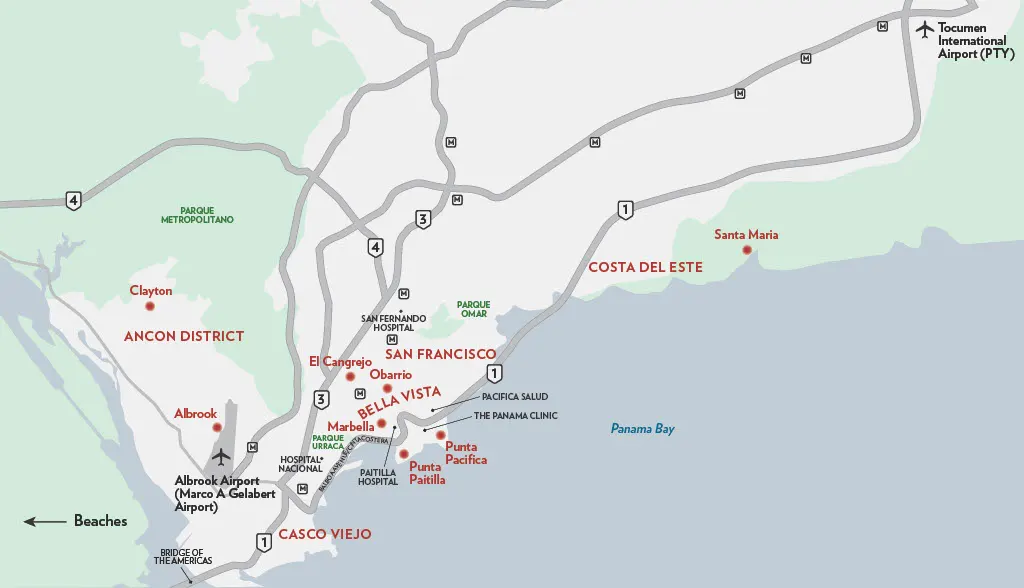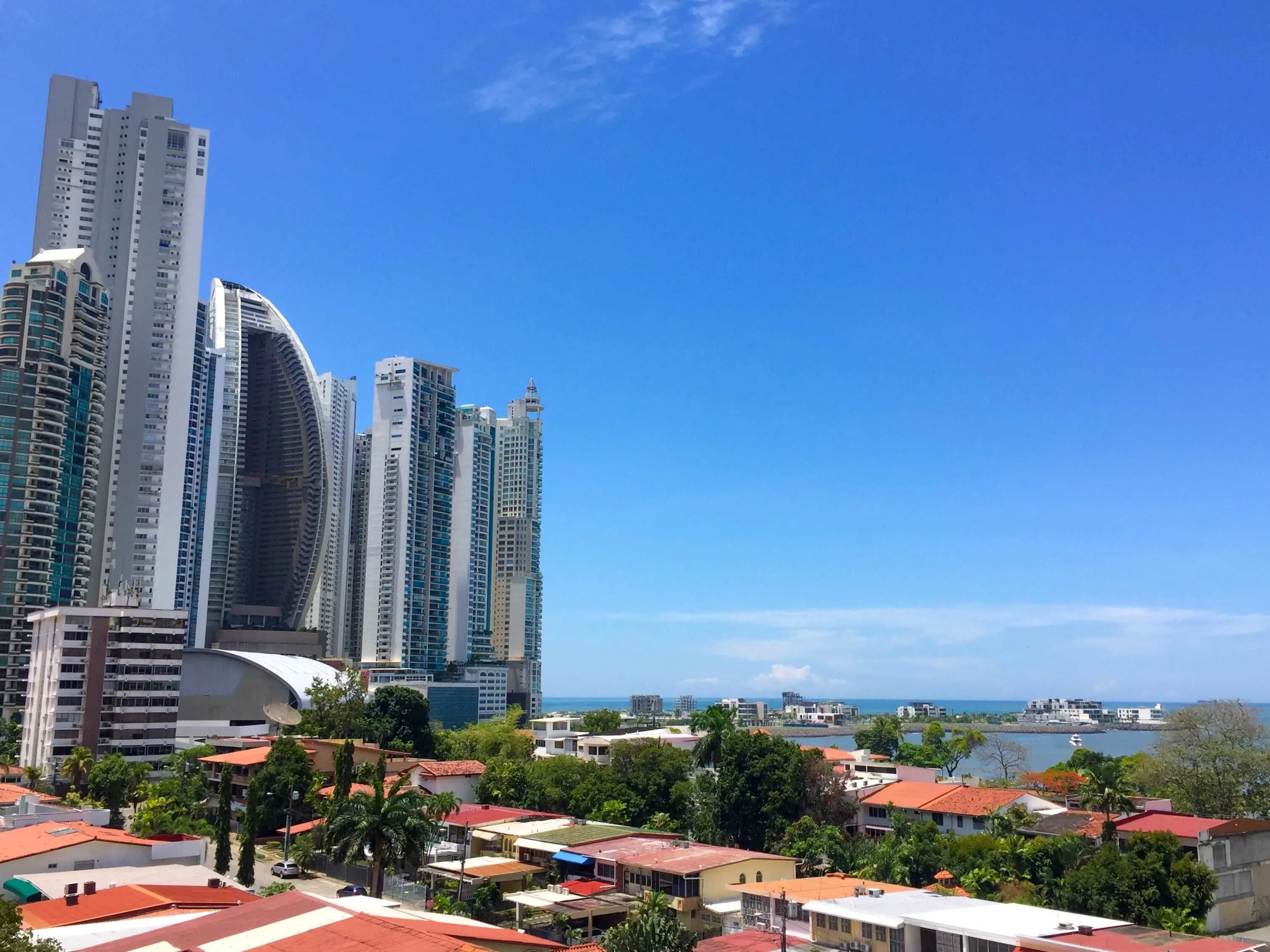Panama City is a labyrinth of stories, flavors, and contradictions. Starbucks might run out of bread, sidewalks are riddled with potholes, and receiving international deliveries is extremely long-winded. Yet I am wholeheartedly convinced that it’s the most livable capital city in Central America and one of the most charming metropolises in the world.
You can start your day hiking in one of two tropical rainforests, spotting toucans and agoutis along the way. You can shop at one of Latin America’s largest malls (Albrook) and spend sunset living the high life at the numerous glittering rooftops in Casco Viejo, the cobblestoned historic quarter. There’s an epic craft beer scene and even an annual craft beer festival every February. Your weekdays can consist of devouring the freshest catch of the day at the fish market, and weekends can be spent further afield investigating Panama’s thousands of islands.

Among Panama City’s many perks, it’s incredibly international, with embassies, multinationals, and maritime trade and commerce enterprises having a foothold there. From a convenience standpoint, Panama is in the top 35 countries with the fastest internet speed, the tap water is drinkable in the capital, and it has a well-functioning metro system to ferry residents between its neighborhoods.
Here are four top neighborhoods to consider when you come to live in Panama City, all of which I have been fortunate to call home.
Get Your Free Panama Report Today!
Get Your Free Panama Report Today!
Learn more about a healthier outdoor life in Panama in our daily postcard e-letter.
Simply enter your email address below and we'll send you a FREE REPORT -- Panama: Easy, First-World Living and the World’s Best Retiree Program.

By submitting your email address, you will receive a free subscription to IL Postcards, Overseas Dream Home, The Untourist Daily and special offers from International Living and our affiliates. You can unsubscribe at any time, and we encourage you to read more about our Privacy Policy.
Avenida Balboa

Living along Avenida Balboa comes with its advantages, including breathtaking views of Panama Bay and easy access to Cinta Costera, a scenic seven-kilometer walkway and recreation area. Most Avenida Balboa condo buildings have gyms, but if you want to exercise outside, this is perfect. Joggers, rollerbladers, Zumba dancers, and yoga enthusiasts share the trails under swaying palm trees. Skate parks, tennis courts, and playgrounds also dot the path, making it suitable for all ages.
Real estate on Avenida Balboa is prime. You can expect to pay top dollar for the views and location. There is a level of prestige associated with taking up residence in one of Balboa’s sky-high condo buildings, like the 75-floor P.H. Yoo, which almost feels like living in a hotel. These buildings tend to have high-end amenities like rooftop pools and expansive social areas. I was always envious of my friends who lived on Balboa when I was more inland, as they had a shorter commute to Casco Viejo, the city’s main hub of activity.
Once I moved to Avenida Balboa, I took advantage of having Cinta Costera on my doorstep, often walking or taking a quick Uber to Mercado de Mariscos. This fish market near Casco Viejo showcases so many things that Panamanians love: good seafood, communal eating, and very loud plena music. Don’t let the various salesmen trying to lure you into their restaurants put you off—go to enjoy a cup of ceviche or a larger plate of something delicious.
Avenida Balboa is a nice middle ground, with the social spoils of Casco Viejo to the east and the more residential enclaves to the west, where the majority of my friends lived.
As a remote worker, I enjoyed having a variety of cafes around me to choose from. The two-level Coffee Bean & Tea Leaf in Balboa Boutiques was always my top choice for the atmosphere and people-watching possibilities. My apartment on Avenida Balboa was also within walking distance of the Riba Smith by Parque Urraca. Riba Smith is a supermarket chain that offers a wide selection of fresh produce, in-house bakeries, and great fish and meat counters.
Walking became my preferred mode of transportation when I lived in this area because everything felt open, safe, and pedestrian-friendly (which is largely not the case in Panama City). I would also stroll over to Marbella, a neighborhood just behind Avenida Balboa, to visit Plaza Punto Marbella for manicures at The Nailbar Marbella, followed by dinner at Buco Pollo or Barrio Pizza.
Another convenience of calling Balboa home is the number of available hotels. If you have visitors in town and they need a place to stay, household-name hotels like Hilton Panama, Waldorf Astoria, Le Méridien Panama, and Intercontinental Miramar are right there.
It should be noted that Avenida Balboa might not be the place for those who cherish silence. With an estimated 75,000 vehicles passing by each day, it’s as close as you can get to living on the edge of a highway. Keeping my apartment windows open meant that surfaces got dusty rather quickly. Balboa is also ground zero during carnival or Fiestas Patrias in November, when Panama celebrates a succession of independence days.
El Cangrejo
When I moved to Panama City, El Cangrejo was my first address. I had relocated from London, England, where the thought of living in a condo building with 24-hour security, a gym, a relaxation area, a swimming pool, and actual sunshine touching my bare skin was a mere pipe dream. El Cangrejo embraced me fully, and I would eventually live there for over a year in a three-bedroom apartment shared with friends for around $1,400 a month.
Founded in the 1950s as Panama's first Jewish quarter, El Cangrejo still nods to its origins with a huge bust of Albert Einstein on Via Argentina. "El Cangrejo" means "The Crab," and it’s a fitting name for a neighborhood with streets that spread out like a crab's claws. It is well connected to the rest of the city, with two metro stops and plenty of Metrobus routes, and it has a lively park, Parque Andrés Bello, which is tucked into the neighborhood like a well-kept secret.
El Cangrejo has a great restaurant scene, and even people who don’t live there pop over. One such destination eatery is El Trapiche on Via Argentina, which might just be the most Panamanian restaurant ever, with patriotic décor and staff dressed in traditional garments. Whenever I had visitors from abroad, I made sure to take them there to try Panama's national dish, sancocho. It’s a hearty broth made with chicken, corn on the cob, starchy vegetables, and a kick of cilantro, and famous for its miraculous ability to cure even the worst colds. Also on Via Argentina, Mentiritas Blancas is run by serious coffee aficionados and is a great spot to enjoy a languid afternoon lunch.
El Cangrejo is a place where you can truly live—whether you’re a family with kids, a single millennial looking for a neighborhood with soul, or a fresh-from-Tocumen Airport arrival, as I was.
Paitilla

Of all my Panama City stomping grounds, Paitilla was where I was the most content. I’m generally big on walking, and I loved that I could go to the supermarket (Super 99), get my nails done, or take a flamenco class, all within a five-minute stroll from my front door. Located right next to Avenida Balboa but thoroughly off the tourist track, Paitilla is where you go when you want some peace and quiet while being close to the action.
Paitilla is a beautiful residential area with a boatload of restaurants, gyms, and specialty stores like Foodie, all within a compact area. I moved there because I found an apartment with great views at P.H. Pacific Sky, which has a shopping mall right across the street. There was nothing I lacked in Paitilla.
While some might say it’s “boring” with not much of a social scene, I was perfectly content merrymaking in Casco or going to neighboring Punta Pacifica to meet friends at dazzling venues like Panaviera, Central America’s highest pool bar.
Get Your Free Panama Report Today!
Get Your Free Panama Report Today!
Learn more about a healthier outdoor life in Panama in our daily postcard e-letter.
Simply enter your email address below and we'll send you a FREE REPORT -- Panama: Easy, First-World Living and the World’s Best Retiree Program.

By submitting your email address, you will receive a free subscription to IL Postcards, Overseas Dream Home, The Untourist Daily and special offers from International Living and our affiliates. You can unsubscribe at any time, and we encourage you to read more about our Privacy Policy.
San Francisco
If you’re the kind of person who judges a neighborhood by its food, then San Francisco is your spot. This area is a gastronomic delight, with plenty of food trucks serving up everything from veggie burgers (at Antiburger) to juicy Argentine choripan (at Esa Flaca Rica). San Francisco is also home to the ATLAPA Convention Center, the largest in the country, which hosts major events throughout the year.
People choose to live in San Francisco if their kids are going to Colegio Europeo Panamá, Don Bosco Technical Institute, or Instituto Italiano Enrico Erni, or if they work in Costa del Este, where many multinationals have their headquarters.
The best thing about living in San Francisco for me was being close to Multiplaza Mall, where I could get all my shopping needs met under one roof: clothing at Estampa, H&M, or Pull & Bear, electrical goods at Panafoto, groceries at Riba Smith, and secure cash withdrawals at BAC or Banco General. Multiplaza also has a Cinépolis cinema.
Overall, I preferred being closer to Cinta Costera in Paitilla, but San Francisco had its charms. Parque Omar is the go-to alfresco workout spot there. This park is the largest in Panama City and is named after Omar Torrijos, the Panamanian military leader whose negotiations over the Panama Canal led to the Carter-Torrijos Treaty of 1979.
San Francisco is a sprawling, largely residential area where it definitely makes sense to have a car. You’ll, therefore, be limitless in your ability to explore the open spaces, intimate, locally loved restaurants, and charming cafes like Miranda Bakery and Café Leto.
Get Your Free Panama Report Today!
Get Your Free Panama Report Today!
Learn more about a healthier outdoor life in Panama in our daily postcard e-letter.
Simply enter your email address below and we'll send you a FREE REPORT -- Panama: Easy, First-World Living and the World’s Best Retiree Program.

By submitting your email address, you will receive a free subscription to IL Postcards, Overseas Dream Home, The Untourist Daily and special offers from International Living and our affiliates. You can unsubscribe at any time, and we encourage you to read more about our Privacy Policy.
